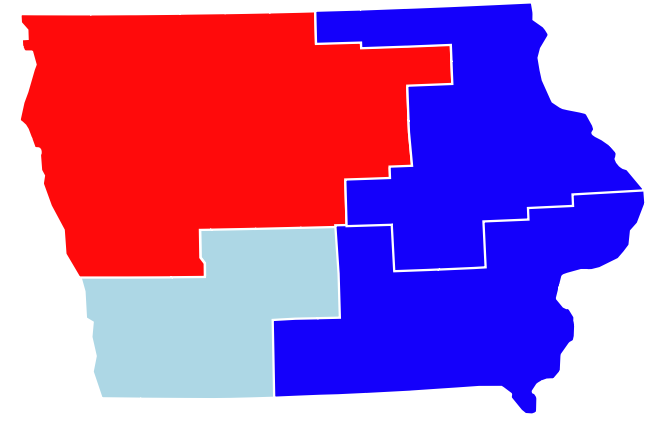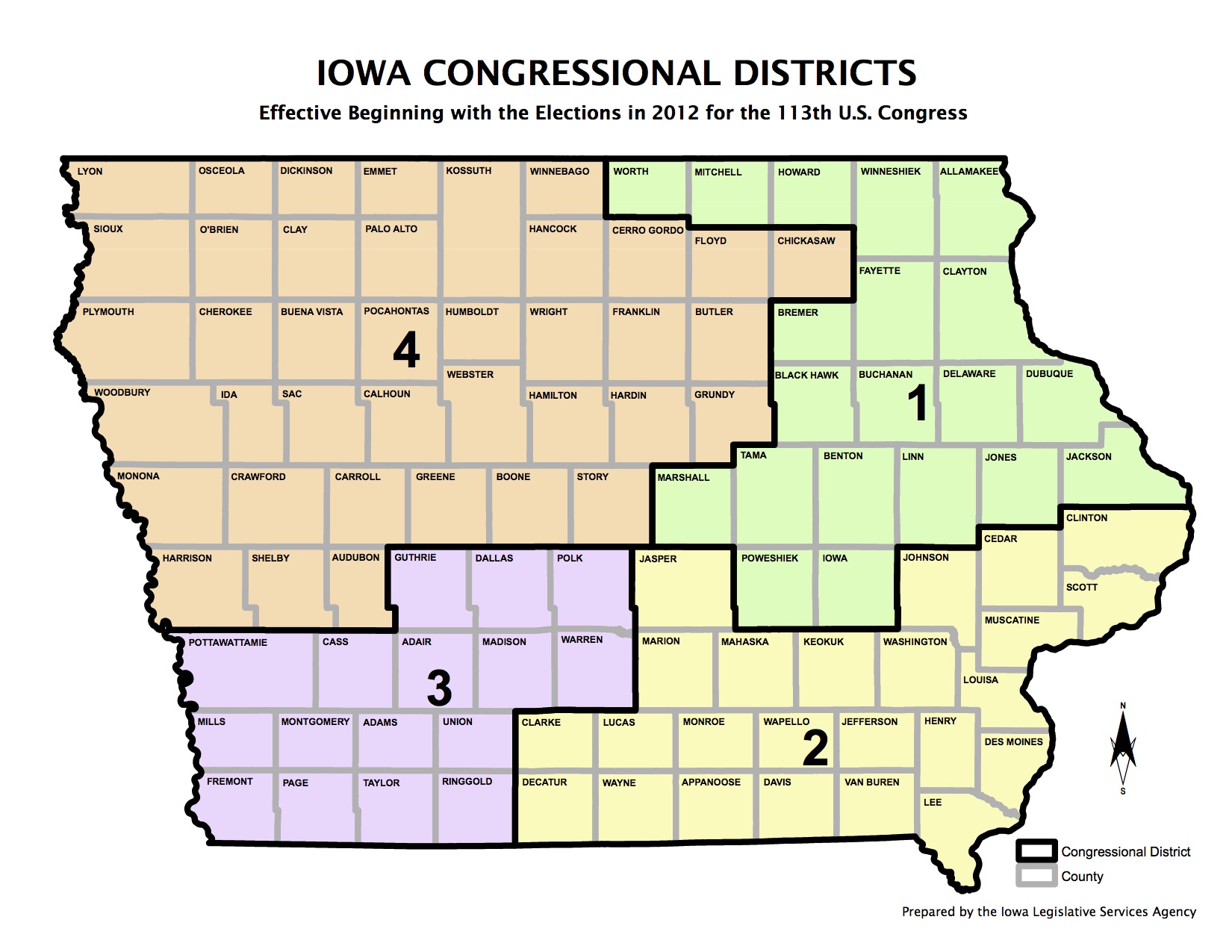Eleventh in a series interpreting the results of Iowa’s 2018 state and federal elections.
David Wasserman, U.S. House editor for the Cook Political Report, planted the seed for this post when he observed last month,
If you’d told me before the election that Rs would win an average of 83% of Trump’s ’16 votes in contested House races, I would’ve told you they were probably on track to keep their majority.
But Dems are averaging 93% of Clinton’s totals & are on track for a 40-seat rout.
— Dave Wasserman (@Redistrict) November 21, 2018
Iowans Abby Finkenauer (IA-01) and Cindy Axne (IA-03) delivered two of those newly-Democratic House seats. I wondered: how did they and their opponents perform compared to their party’s last presidential nominee?
IOWA VOTES FOR PRESIDENT 2016 AND CONGRESS 2018
Click on any district on the map below to show the total votes and percentages for Hillary Clinton and Donald Trump in 2016, as well as this year’s results for the Democratic and Republican candidates for Congress.
County-level results for the last presidential election can be found in the Iowa Secretary of State’s canvass summary (all 99 counties in alphabetical order) or on the Daily Kos Elections team’s spreadsheet (counties grouped by Congressional district).
Numbers for this year’s U.S. House races come from the Secretary of State’s results site. All counties have reported official numbers.
County Name
| D | Canidate 1 | 61% | 30390 |
| R | Canidate 2 | 39% | 10390 |
Democrat won 2018 Congressional race with more than 50%
Democrat won 2018 Congressional race with less than 50%
Republican won 2018 Congressional race with more than 50%
I put an asterisk next to some numbers for the third Congressional district, because the official results from 2016 do not include 5,842 absentee ballots from Dallas County. Due to an egregious oversight by staff in the county auditor’s and Secretary of State’s offices, those votes were never counted.
So Clinton and Trump should each have received some 2,500 to 3,000 additional votes in IA-03. (Democrats are more likely than Republicans to vote early.) If those numbers had been tabulated, this year’s totals for Axne and Young would have comprised a slightly lower percentage of the votes cast for their party’s last presidential nominee.
For readers who prefer tables to maps, here are the same figures:
| Iowa presidential voting 2016 and Congressional voting 2018 | ||
| Candidate | Total votes | Share of vote |
|---|---|---|
| IA-01 | ||
| Clinton (D) 2016 | 176,535 | 45.2% |
| Trump (R) 2016 | 190,410 | 48.7% |
| Finkenauer (D) 2018 | 170,342 | 51.0% |
| Blum (R) 2018 | 153,442 | 45.9% |
| Finkenauer share of Clinton vote: 96.5% | ||
| Blum share of Trump vote: 80.6% | ||
| IA-02 | ||
| Clinton (D) 2016 | 170,796 | 45.0% |
| Trump (R) 2016 | 186,384 | 49.1% |
| Loebsack (D) 2018 | 171,446 | 54.8% |
| Peters (R) 2018 | 133,287 | 42.6% |
| Loebsack share of Clinton vote: 100.4% | ||
| Peters share of Trump vote: 71.5% | ||
| IA-03 | ||
| Clinton (D) 2016 | 181,524* | 45.0% |
| Trump (R) 2016 | 195,740* | 48.6% |
| Axne (D) 2018 | 175,642 | 49.3% |
| Young (R) 2018 | 167,933 | 47.1% |
| Axne share of Clinton vote: 96.8%* | ||
| Young share of Trump vote: 85.8%* | ||
| IA-04 | ||
| Clinton (D) 2016 | 127,401 | 33.5% |
| Trump (R) 2016 | 231,229 | 60.9% |
| Scholten (D) 2018 | 147,246 | 47.0% |
| King (R) 2018 | 157,676 | 50.3% |
| Scholten share of Clinton vote: 115.6% | ||
| King share of Trump vote: 68.2% | ||
The first and third districts were among the most competitive House races in the country. Bleeding Heartland discussed the IA-01 results in more depth here and the IA-03 results here.
Democratic challenger Abby Finkenauer and two-term Republican incumbent Rod Blum combined to spend more than $6 million in IA-01, and outside groups spent more than $3.5 million to influence the outcome. Spending by Democratic contender Cindy Axne and two-term GOP incumbent David Young exceeded $6 million, and outside groups invested another $8.7 million in the IA-03 race.
Blum and Young each ran about 5 points ahead of Trump in their districts two years ago. Young has had better constituent service, been less abrasive in public appearances, and more diligent about holding events around his district, which probably explains why he performed better this year than Blum did.
Axne and Finkenauer nearly matched Clinton’s vote totals in their districts, suggesting a strong effort to mobilize the Democratic base as well as a successful persuasion campaign with swing voters. Granted, turnout was unusually high for an Iowa midterm. Even so, about 220,000 fewer people participated statewide compared to the last general election (1,334,279 ballots cast this year, 1,553,984 votes for president in 2016).
Six-term Representative Dave Loebsack ran about 9 points ahead of Clinton in the 24 counties that make up the second district two years ago. Neither party targeted IA-02 this year, and Loebsack raised and spent more than twice as much as GOP challenger Christopher Peters. For all those reasons, it’s not surprising the incumbent was able to surpass Clinton’s result.
Representative Steve King’s slippage is notable. Two years ago, he was the only Iowan in Congress who failed to significantly outperform his party’s presidential nominee. King won his eighth term with about 61.2 percent of the vote; Trump received 60.9 percent in the 39 counties that make up IA-04.
While Blum and Young gained more than 80 percent as many votes this year as Trump won on their turf two years ago, King barely managed two-thirds of Trump’s total. Even in Iowa’s most conservative district, voters are losing patience with a representative who often makes national news with racist remarks but doesn’t put in the legwork at home.
J.D. Scholten gave King the scare of his political life by running a phenomenal campaign, with a relatable message and at least three events in every county. He also out-raised and out-spent the incumbent. Few outside groups got involved in the IA-04 race, but most of the independent expenditures opposed King.
Until this summer, few political junkies saw IA-04 as potentially competitive. Major forecasters viewed the race as “likely Republican” until the final week. But if Scholten decides to take another crack at this district, he will instantly be taken seriously. He’s not ruling anything out.
Worth noting: Scholten’s mentor Tom Harkin lost his first Congressional race but beat the Republican incumbent in a rematch two years later.
Any comments about this year’s U.S. House elections are welcome in this thread.


